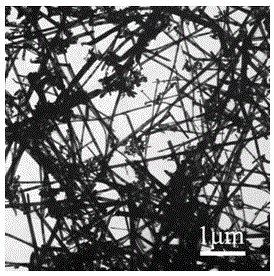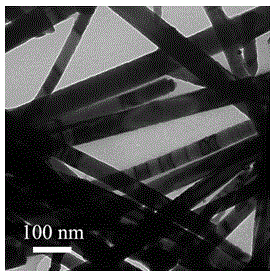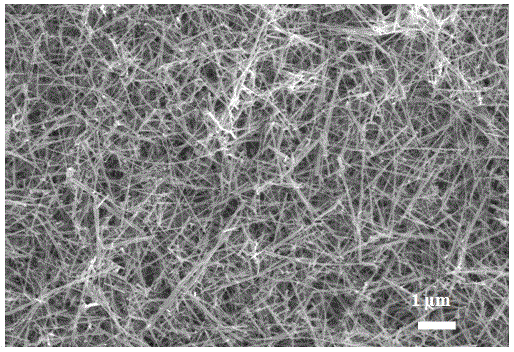A method for catalytically preparing copper indium tellurium nanowires
A catalytic preparation, copper indium tellurium technology, applied in nanotechnology, nanotechnology, nanotechnology for materials and surface science, etc., can solve the problem that the preparation method of copper indium tellurium nanowires has not yet been reported, and achieves cheap equipment and equipment. , the effect of easy operation
- Summary
- Abstract
- Description
- Claims
- Application Information
AI Technical Summary
Problems solved by technology
Method used
Image
Examples
Embodiment 1
[0035] 1. Preparation of catalyst - toluene solution of bismuth nanoparticles:
[0036] Mix 0.5 mL of bis(trimethylsilyl)amide bismuth content of 1 mol / L tetrahydrofuran solution of bis(trimethylsilyl)amide bismuth and 2 mL of bis(trimethylsilyl)amide sodium content of 1 mol / L The tetrahydrofuran solution of sodium bis(trimethylsilyl)amide of L was mixed to form a mixed solution containing bismuth precursor, which was placed in a syringe.
[0037] Another 5 g of polyvinylpyrrolidone-hexadecane block copolymer and 15 g of diphenyl ether were magnetically stirred and heated to 180° C. under nitrogen protection to form a reaction system.
[0038]The mixed solution containing bismuth precursor was injected into the reaction system, and the solution changed color rapidly to black. After reacting for 30 minutes, remove the heat source, cool to room temperature, then add 30mL of methanol and centrifuge, use a mixed solvent of toluene and methanol to repeatedly disperse and centrifug...
Embodiment 2
[0048] 1. Preparation of catalyst - toluene solution of bismuth nanoparticles:
[0049] Mix 0.5 mL of 1 mol / L bis(trimethylsilyl)aminobismuth tetrahydrofuran solution with a content of bis(trimethylsilyl)amide bismuth and 2 mL of bis(trimethylsilyl)amide with a content of 1 mol / L The tetrahydrofuran solution of sodium bis(trimethylsilyl)amide of L was mixed to form a mixed solution containing bismuth precursor, which was placed in a syringe.
[0050] Another 5 g of polyvinylpyrrolidone-hexadecane block copolymer and 15 g of diphenyl ether were magnetically stirred and heated to 180° C. under nitrogen protection to form a reaction system.
[0051] The mixed solution containing bismuth precursor was injected into the reaction system, and the solution changed color rapidly to black. After reacting for 30 minutes, remove the heat source, cool to room temperature, then add 30mL of methanol and centrifuge, use a mixed solvent of toluene and methanol to repeatedly disperse and centr...
Embodiment 3
[0061] 1. Preparation of catalyst - toluene solution of bismuth nanoparticles:
[0062] Mix 0.5 mL of 1 mol / L bis(trimethylsilyl)aminobismuth tetrahydrofuran solution with a content of bis(trimethylsilyl)amide bismuth and 2 mL of bis(trimethylsilyl)amide with a content of 1 mol / L The tetrahydrofuran solution of sodium bis(trimethylsilyl)amide of L was mixed to form a mixed solution containing bismuth precursor, which was placed in a syringe.
[0063] Another 5 g of polyvinylpyrrolidone-hexadecane block copolymer and 15 g of diphenyl ether were magnetically stirred and heated to 180° C. under nitrogen protection to form a reaction system.
[0064] The mixed solution containing bismuth precursor was injected into the reaction system, and the solution changed color rapidly to black. After reacting for 30 minutes, remove the heat source, cool to room temperature, then add 30mL of methanol and centrifuge, use a mixed solvent of toluene and methanol to repeatedly disperse and centr...
PUM
| Property | Measurement | Unit |
|---|---|---|
| concentration | aaaaa | aaaaa |
| diameter | aaaaa | aaaaa |
| diameter | aaaaa | aaaaa |
Abstract
Description
Claims
Application Information
 Login to View More
Login to View More - R&D
- Intellectual Property
- Life Sciences
- Materials
- Tech Scout
- Unparalleled Data Quality
- Higher Quality Content
- 60% Fewer Hallucinations
Browse by: Latest US Patents, China's latest patents, Technical Efficacy Thesaurus, Application Domain, Technology Topic, Popular Technical Reports.
© 2025 PatSnap. All rights reserved.Legal|Privacy policy|Modern Slavery Act Transparency Statement|Sitemap|About US| Contact US: help@patsnap.com



